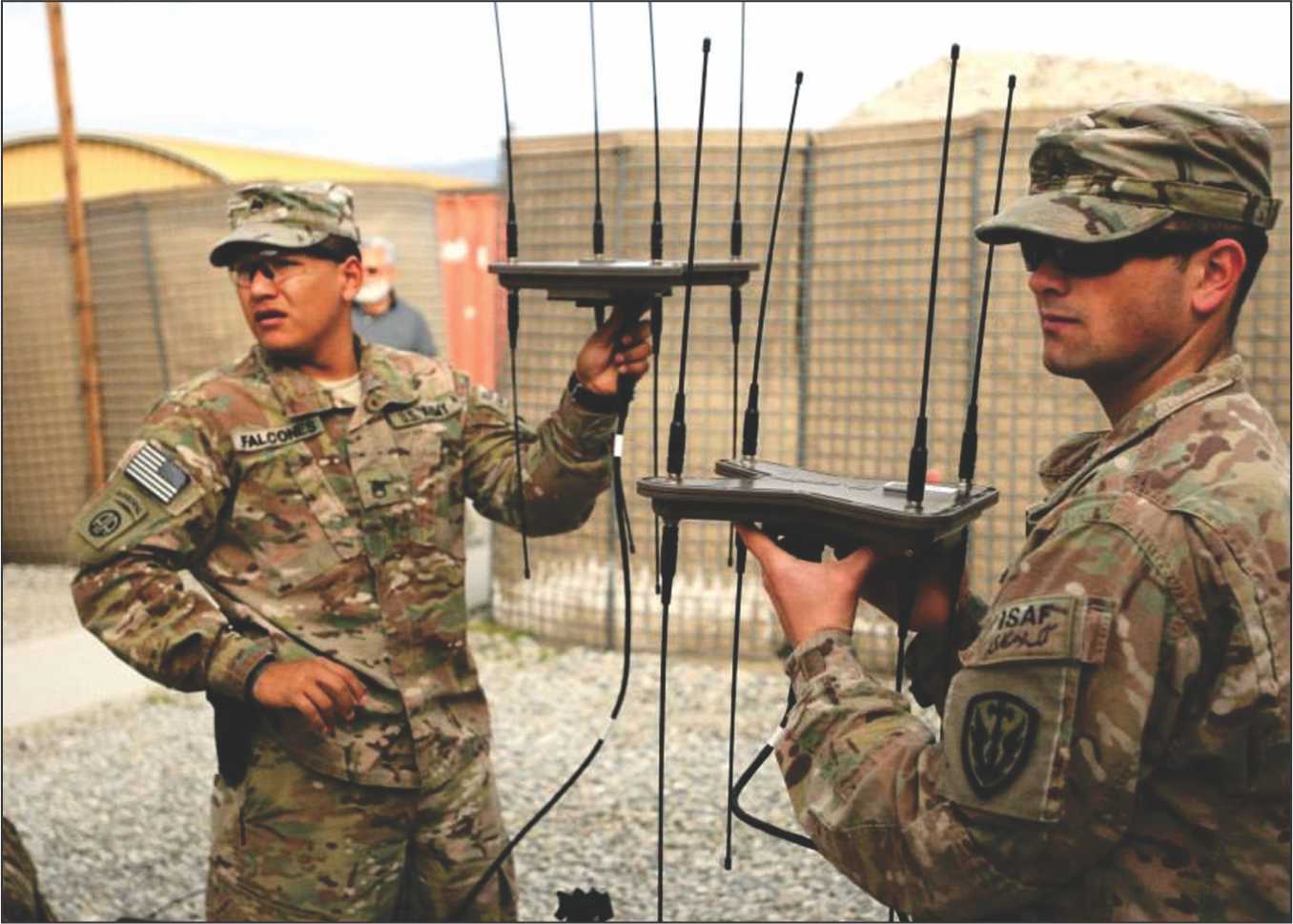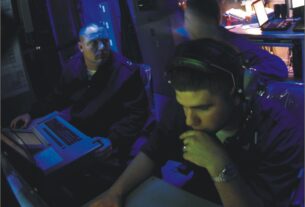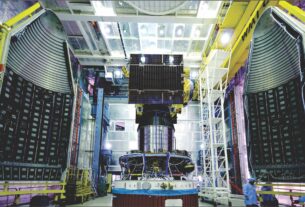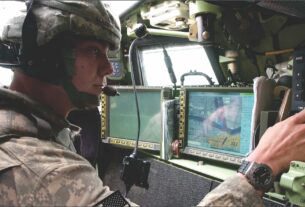Timely intelligence gathering through a range of space based platforms as well as land, ocean and air based devices holds the key to a smart warfare strategy designed to stay at the winning edge of the battlefield.
Indeed, automation, stealth, real time information collection, sharing of data among the fighting platforms and defence forces cutting across the services jurisdiction and geographical spread, are some of the critical factors shaping a successful intelligence intensive warfare strategy.
Remote manipulation and a well planned deployment of unmanned surveillance and fighting platforms are among the innovations that are fast changing the contours of the emerging intelligent warfare.
Satellites, computers and communications networks that help in the seamless integration of fighting platforms, command centres and defence forces have all become puppets in the chain of the contemporary warfare strategy.
Enhanced situational awareness and information dominance makes for an excellent combination in sustaining the winning edge of the war. According to a report by the Headquarters of US Department of Army, the intelligence preparation of the battlefield is a systematic, continuous process of analysing the threat and environment in a specific geographic area. It is designed to support staff estimates and military decision making.
For in the ultimate analysis, having right type of information at right time on the finger tips makes for a “smoother and superior” warfare strategy focussed on taking the adversaries by surprise.
Defence intelligence
India’s Defence Intelligence Agency (DIA) set up in 2002 is responsible for providing and coordinating the intelligence for the Indian armed forces. DIA has two important units under its command to boost the defence intelligence- the Directorate of Signals Intelligence and Defence Image Processing and Analysis Centre (DIPAC). While the Signals Directorate is responsible for acquiring and decrypting enemy communications, the DIPAC controls India’s satellite based image acquisition capabilities.
It was the massive intelligence failure suffered by Indian defence forces before and during the 1999 Kargil skirmish with Pakistan that brought home the need for well coordinated intelligence machinery supported by a range of high performance satellites, a smart communications grid in tandem with computer power as well as a range of intelligence gathering electronic devices. In particular, the Indian Army has projected the need for a range of exclusive earth observation satellites capable of gathering data round the clock even under hostile atmospheric and environmental conditions for boosting its intelligence gathering capability in all its manifestations.
Of course, the Indian Army has limited access to the earth observation spacecraft constellation being operated by Indian Space Research Organisation (ISRO). But in the context of the changing security environment in India’s immediate neighbourhood, the Indian defence forces may need to have under their operational command, a constellation of exclusive satellites for applications including surveillance and reconnaissance.
Indeed, satellites high up in the skies, can serve as “ears”, “eyes” and “command posts” of the Indian defence forces. Of course, Defence Research and Development Organisation (DRDO) has unveiled a plan for a range of dedicated defence satellites for the exclusive use of the three wings of services.
However, DRDO has not provided details as to the number of these dedicated defence satellites and their launch schedule. Of course, these satellites need to be launched in cooperation with the Indian Space Research Organisation (ISRO). There is no denying the point that satellites meant for a variety of end uses could play a decisive role in sharpening the intelligence gathering edge of the Indian defence forces.
However, the biggest concern is that whether ISRO with its limited infrastructure for building and launching satellites would be in a position to fully well cater to the rapidly expanding “space resources” needs of the Indian defence forces. Perhaps the best way out would be the setting up a full fledged defence space agency that could initially draw from the resources of ISRO and DRDO.
According to fifteen years Technology Perspective and Capability Road Map (TPCR), unveiled by India’s Defence Ministry, in keeping with the global trends, it would be ideal to go in for developing and deploying small and inexpensive satellites for boosting the intelligence gathering capability of the Indian defence forces.
For it is felt that these small satellites placed in low earth orbits-that would need to be replenished periodically-would serve the purpose of expanding Indian military’s intelligence, surveillance and reconnaissance capabilities.
With miniaturization, the future trends should be towards smaller satellites. In fact, a network of satellites capable of working together should be capable of seeing a moving target on the ground or at sea anywhere in the world,” says the roadmap. This roadmap also envisages an ambitious plan for a satellite based communications network with high data rates and multi-band operations for voice, data and allied applications.
Satellite use
Meanwhile, the state owned DRDO has unveiled a plan for building an electronic intelligence satellite for the exclusive use of defence forces. This satellite featuring a synthetic aperture radar and planned to be located in low earth orbit would be particularly useful for intelligence gathering along India’s international borders with China and Pakistan.
This satellite, expected to be launched by means of an ISRO launch vehicle sometime during 2015-16 time-frame will be a space platform capable of functioning under the cover of darkness and under varying atmospheric and environmental conditions.
Sometime back, Avinash Chander, Director General of DRDO had stressed on the need for India to put in place an effective mechanism to fully monitor Indian Ocean Region (IOR) in a complete and three dimensional manner.
To accomplish this objective, he has suggested the development and deployment of about 80-100 satellites designed for covering the IOR. There are said to be 19 Chinese satellites keeping a round the clock watch over the IOR. As it is, the growing Chinese space based ocean surveillance capability with particular reference to the Indian Ocean has been a matter of concern for US strategic planners.
In recent years, ocean observation space platforms have emerged as a major technological tool to keep a tab on the oceanic expanse on a sustained basis with a high degree of effectiveness. Of course, ISRO has a sound track record in developing and deploying state of the art ocean watch satellites.
Meanwhile, the Indian Navy whose current primary area of focus is on IOR has acquired an “eye in the sky” in the form India’s fully home-grown GSAT-7 multi band communications satellite launched in August 2013.
This space platform would help the Indian Navy keep a tab on IOR with a vastly enhanced vigour. Further, it would facilitate the real time networking of all the Indian warships, submarines and deck based fighters and helicopters with the onshore operational centre.
The 2625-kg Rukmini, as the satellite is known, will also help the Indian Navy keep a hawk eye in the Arabian Sea and Bay of Bengal regions where arms running and sea piracy are reported with recurring regularity. Moreover with an enhanced situational awareness that this satellite will bring to the Indian Navy, it would be possible to keep a hawk’s eye on the possibility of armed terrorists using the sea channels to mount attack on the mainland India.
Similarly, the easy access that Indian armed forces would have to India’s home-grown navigational constellation IRNSS (Indian Regional Navigation Satellite System) will prove to be a game changer. As it is, the satellite navigation capability would help Indian defence forces enhance its situational awareness and improve the hitting accuracy of its precision weapons including long range missiles.
The seven spacecraft IRNSS constellation is an independent regional navigation satellite system that would be capable of providing a range of service to the Indian defence forces.
In addition to exploiting the satellite capability for intelligence gathering at all levels of operations, Indian defence forces should also make use of advances in communications and sensor technologies to give a “greater punch and thrust” to its warfare strategy. However, keeping the information and communications networks and support systems in an operational trim in the context of the expanding scope of “cyber war” has assumed more than usual importance.
As strategic analysts points out, Trojan Horse (programs hidden in another program and capable of destroying the content of an information network), Logic Bomb (programs that inject viruses and worms into a system that are remotely activated or else are triggered by certain programs or commands acting as detonators), hyper frequency guns (radio pulses that disturb electronic components) and microwave guns installed on a platform that generate a very short but powerful pulses capable of impairing or paralysing of electronic systems have all become important components of the modern day intelligence warfare.
Electronic warfare
Meanwhile, India’s state owned defence enterprise, Bharat Electronics Limited (BEL), has unveiled a plan to invest US$100-million over the next five years on developing electronic warfare products jointly with the DRDO.
As one of the leading defence electronics firm, BEL manufactures and supplies wide ranging EW products including radars, sensors and communications devices to the Indian armed forces.
Samyukta, a mobile electronic warfare system has been developed jointly by DRDO, BEL, Electronics Corporation of India Limited (ECIL) and Army Corps of Signals to give a tactical edge to the defence forces in the battlefield by covering a wide range of frequencies.
It has both electronic intelligence and communications intelligence capabilities built into it. The Samyukta development program, to which around 40 Indian micro, small and medium industries have contributed, could serve as a platform for the development of futuristic EW systems. The system made up of 40 entities has the capability for surveillance, interception, monitoring, analysis, recording, location fixing and jamming of all communications and radar signals.
Significantly, DRDO has made an appreciable contribution to strengthen the intelligence gathering capability of the Indian Army by successfully developing a range of systems including radar warning receivers, high accuracy direction finding pods, Synthetic Aperture Radar (SAR) and Active Electronically Scanned Array(AESA) radar.
The development of Weapon Locating Radar (WLR) by the Bangalore based Electronics and Radar Development Establishment (LRDE) of DRDO is considered a force multiplier for Indian defence forces. This radar based on the state of the art phased array radar technology is produced by BEL.
WLRs can easily locate hostile artillery/mortar units and rocket launchers. It is also capable of tracking friendly artillery fire to locate its impact points and issue necessary corrections. WLR is designed to detect projectiles with small cross sections across the battle space horizon and has the capability to handle simultaneous fire from weapons located at multiple sites. Capability to locate positions of enemy weapon systems offers a great advantage in the battlefield. DRDO has also hinted at developing what is described as a foliage penetrating radar that could help the Indian defence forces target the enemy troops hiding under the cover of foliage or vegetation.
The Long Range Solid State Active Phased Array Radar designed and developed by LRDE stands out as a technology feeder to the AEW&C (Air borne Early Warning and Control) system developed by Bangalore based Centre for Airborne Systems (CABS).
CABS would also be developing India’s Airborne Warning and Control System (AWACS) that would be a big boost to the Indian electronic warfare efforts. As envisaged now, two AWACS will be developed initially followed by four more at a later stage. However, the aircraft that would serve as the test bed and platform for the home grown AWACS system is yet to be identified. All said and done, the design and development work on the indigenous AWACS could gather momentum only after the kind of the aircraft on which it would be mounted is identified. But then there is no denying the point that the need for AWACS will be felt acutely during conflict situation with China and Pakistan, both of which are in possession of long range ballistic and cruise missiles.
Right now, three Israeli origin AWACS system with Phalcon radar are in service with the Indian Air Force (IAF). This AWACS, mounted on the Russian IL-76 medium transport aircraft, provides 360 degree coverage in all directions in addition to making available sufficient warning and reaction time to facilitate the launching of counter measures. Incidentally, these three AWACS were imported from Israel under a contract worth about US$1.1 billion. AWACS acquired from Israel are now part of the network centric operations and are able to provide sufficient coverage of specified area. However for now, the plan to acquire three more AWACS from Israel seems to have been shelved. Former IAF chief NAK Browne had highlighted the need for five high end AWACS and ten medium AEW&C systems. Indian strategic experts are of view that India should have sufficient number of AWACS to take care of its security needs in the years ahead.
Meanwhile, CABS has covered much ground in the development of the indigenous AEW&C system that has as its platform as EMB-145 aircraft of the Brazilian aerospace major Embraer. Brazilian Embraer aircraft EMB-145 was chosen as a platform because Brazil, Mexico and Greece based their AEW&C systems on this aircraft. The choice of EMB-145 as a platform of Indian AEW&C was finalized after ensuring that the aircraft with a MTOW (maximum take off weight) of 24 ton would optimally meet the requirements of the AEW&C system including the ability to operate from most of the military airfields in the country. In all, three EMB-145 aircraft have been ordered for mounting the Indian AEW&C system.
The Indian made AESA radar is the primary sensor for the indigenous AEW&C. AESA which has a range of 350 kms does surveillance operations. It can track more than 500 targets simultaneously. The Secondary Surveillance Radar (SSR) helps identify the target as Friend or Foe (IFF). The AEW&C system with its ability sense war like situations in the air to air, air to surface, all weather and day and night modes, have emerged as “force multipliers” in today’s military tactical operations. The primary function of the AEW&C include sensing the threat scenario, providing early warning and enabling execution of counter measures and counter threats.
On the other hand, Bangalore based DARE (Defence Avionics Research Establishment) has successfully equipped Indian fighter aircraft and warships of the Indian Navy with electronic support measures and self protection jammers. DARE has made signal contribution to the fields of air borne electronic warfare. The Electronic Warfare wing of DARE focuses on the design and development of radar warning systems and warfare suites for various aircraft to enhance their survivability and mission accomplishments.
To boost its intelligence gathering capability, Indian armed forces should focus on deploying remotely operated unmanned aerial vehicles featuring latest genre technological systems. India should also develop weaponized version of UAVs to hit the identified targets with a high degree of precision. The stunning success with which the Central Intelligence Agency (CIA) of USA deployed drones to identify and destroy militant hideouts in the difficult to access, remotely located mountainous stretches in the North Western parts of Pakistan stands out as a testimony to the power wielded by drones in the modern day intelligent warfare strategy.
By all means, the unmanned, remotely controlled and operated weaponized aerial platforms featuring intelligence, autonomy and cognitive faculties are radically transforming the very shape and dynamics of the contemporary battlefield scenario with stunning effects.
Rapid technological advances in the areas including electro optics, robotics, sensing, stealth and micro miniaturization are all contributing in a big way to the design and development of smarter and more lethal breed of new generation unmanned fighting platforms. Indian defence establishment, defence industries in the country as well as research and development organisations better take cognizance of this emerging trend and help the country prepare for the warfare of the future that is intelligence dominant and information intensive.





